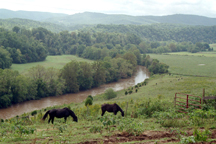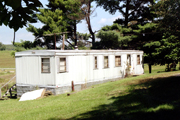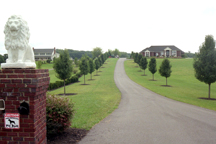 Sprawl
Is All Around
Sprawl
Is All AroundBy Guy Span
We call it “Urban Sprawl” and bemoan the little
towns, fields and woodlands around our big cities getting gobbled up
for townhouse developments, some as far as 80 miles from the urban
centers. The automobile (increasingly, the politically incorrect
SUV) is indeed the engine that drives this cancer-like growth that
seems to have few, if any, limits. We like to think of this problem
as an “Urban” problem and the focus of our ineffective restraint has
been around our larger cities and their inhospitable housing prices.
 |
| The Store at
Childress, VA stands abandoned. |
The fact is, this is more a suburban and
increasingly a rural problem. For one who had a portion of his
misspent childhood in a deeply rural area, revisiting that area
brings two huge
 |
| A Small farm hangs
on in a “View Lot” between Snowville and Indian Valley,
overlooking Little River. |
contrasts. First of all, in rural Montgomery
County, located between the Appalachian and the Shenandoah Mountains
(in the heart of the New River Valley of Virginia), we find vastly
improved county roads. These roads used to be one-lane gravel
affairs, patrolled and repaired by chain gangs.
Now, some forty years later, many have wider
pavement and even bright, yellow lines dividing the lanes, replacing
the anarchy of unlined roads. Suddenly “town,” be it Radford,
Pulaski or Christiansburg is much closer and no longer the all day
trek it once was. A Wal-Mart Superstore (that means it has a grocery
division) moved into Radford and the little country stores out in
the middle of nowhere dropped like flies. Nearly every country road
has one or two abandoned general stores that also used to sell
gasoline.
The little villages such as Grayson Town,
Snowville, Childress and Hiawassee all lost their stores and even
Main St. in Radford and Roanoke St. in Christiansburg have their own
vacant storefronts. All thanks to the fact that rural residents can
now drive to town in twenty to thirty minutes and find a “Big Box”
store with plenty of parking near excellent paved roads.
 That
same mobility is having an effect on the farms and grazing land in
this fairly steeply sloped mountain area. Many farms are falling to
the wayside and being replaced by “View Lots” with five acres of
carefully manicured lawns, overseen by “Mac Mansions.” And where
there is not enough income, these lots sport single and doublewide
trailers, each with its own well and septic tank. Zoning is
virtually non-existent and little developments spring up anywhere
someone would sell a farm.
That
same mobility is having an effect on the farms and grazing land in
this fairly steeply sloped mountain area. Many farms are falling to
the wayside and being replaced by “View Lots” with five acres of
carefully manicured lawns, overseen by “Mac Mansions.” And where
there is not enough income, these lots sport single and doublewide
trailers, each with its own well and septic tank. Zoning is
virtually non-existent and little developments spring up anywhere
someone would sell a farm.
These new residents work at the Radford Arsenal or the steel
mini-mill or manage the other big box stores that serve
Christiansburg. Perhaps they drive fifty to sixty miles up I-81 to
work in Roanoke, a city of aquarter of a million in the heart of the
Shenandoah Valley. Either way, the family farms are falling as the
new residents encroach upon what was the countryside.
 And
of course, unless one buys fifty to sixty acres, a “View Lot”
becomes a lot with a view of other homes, not the rolling wooded
countryside. The county earns more off the smaller improved parcels
in tax, so it has no desire to change the status quo. The farmer,
whether it’s dairy, grazing, corn or Christmas trees pays a higher
tax as the value of his holding increases. In turn, this eases for
way for retirement, as selling in smaller parcels earns more than
farming ever did.
And
of course, unless one buys fifty to sixty acres, a “View Lot”
becomes a lot with a view of other homes, not the rolling wooded
countryside. The county earns more off the smaller improved parcels
in tax, so it has no desire to change the status quo. The farmer,
whether it’s dairy, grazing, corn or Christmas trees pays a higher
tax as the value of his holding increases. In turn, this eases for
way for retirement, as selling in smaller parcels earns more than
farming ever did.
This frightening trend shows no signs of abating
and is rarely controlled by such actions as Bedford County limiting
rural properties to a 3-acre minimum. Our need for more and cheaper
housing, such amenities as “View Lots” and the like will continued
to be fueled by cheap transportation costs until either we run out
of fuel or sprawl is all around.